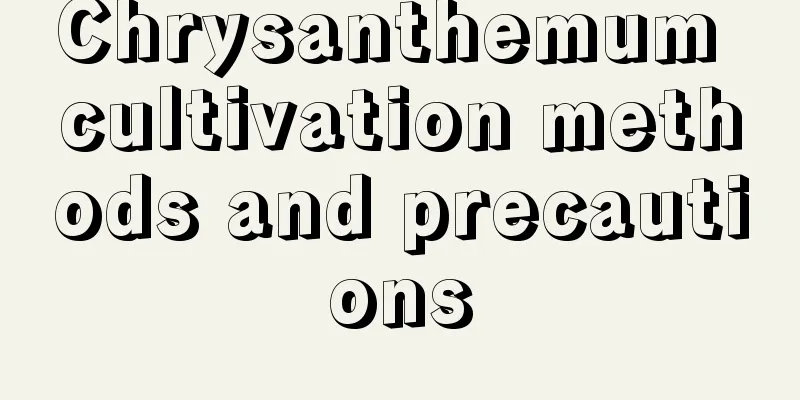Chrysanthemum cultivation methods and precautions

|
Chrysanthemums generally prefer mild climatic conditions. The most suitable growth temperature range is 18 to 22 degrees Celsius. The highest temperature they can withstand is 32 degrees Celsius, while the lowest temperature is not lower than 10 degrees Celsius. Chrysanthemums require that the soil be rich in humus, fertile, loose, and have good drainage properties. They grow best in sandy loam with a slightly acidic to neutral pH value. Let’s learn about the cultivation and breeding methods and precautions of chrysanthemums. 1. Breeding time Cutting propagation of chrysanthemums is usually carried out in spring from April to June, with May being considered the best time. 2. Soil selection Chrysanthemums prefer high-lying, well-drained, deep soil, and sandy loam that is rich in humus, loose and fertile is most suitable. They thrive in slightly acidic to neutral soil with a pH of 6.2 to 6.7. 3. Humidity management As a shallow-rooted plant, chrysanthemum requires an appropriate amount of water. It is drought-tolerant but does not like an overly humid environment. During heavy rain season, good drainage should be ensured to avoid water accumulation. 4. Temperature requirements The most suitable temperature for chrysanthemum growth is about 20℃. They are highly adaptable and cold-resistant. The suitable temperature for their growth is between 18 and 21°C. They can tolerate a maximum of 32°C and a minimum of no less than 10°C. The minimum night temperature during the flowering period should be maintained at 17°C, while it can drop to 15 to 13°C in the middle and late flowering period. 5. Lighting requirements Chrysanthemums are short-day plants, and shorter daylight hours help promote flowering. 6. Fertilization points Apply sufficient base fertilizer when planting, and then apply nitrogen fertilizer every 10 days. From the beginning of autumn to the appearance of buds, apply fertilizer and water with moderate concentration once a week; after the flower buds are formed, apply concentrated fertilizer and water again, and then stop fertilizing. During the growth period, organic fertilizer is used as base fertilizer, and topdressing is mainly nitrogen fertilizer, combined with phosphorus, potassium fertilizer and trace elements. In the middle and late stages of growth, use phosphorus and potassium fertilizers mainly, combined with special fertilizers for flowers , and use soil and foliar fertilizers. 7. Watering tips Water less in spring and more in summer, and pay attention to increasing the humidity of the environment. Control water and fertilizer before the beginning of autumn, and increase the amount of watering before flowering. Strictly control watering in winter to avoid overhumidification. Use a watering can when watering, and avoid watering directly. Adjust watering amount and frequency according to season and weather. 8. Pruning method When the plant grows to a certain height, start pinching the top to promote branching and control height and shape. When pruning, remove excess branches and retain 3 to 5 main branches. When buds appear, remove the lower buds and leave one top bud on each branch. 9. Replace potting soil When repotting, first water with light fertilizer, prepare the flower pot and soil, gently knock out the soil, put it in the new pot, fill it with soil and water it thoroughly. 10. Reproduction method Vegetative propagation includes cuttings, division, grafting, layering and tissue culture. Cuttings are divided into bud cuttings, softwood cuttings and leaf bud cuttings, and softwood cuttings are usually the main method. Division is carried out during the Qingming Festival, and grafting uses Artemisia annua or Artemisia annua as rootstock. The suitable temperature for seed germination is 25℃. If sown from February to April, the seeds will bloom in the same year. 11. Disease and pest control Spot blight and wilt are controlled by removing diseased plants and spraying pesticides. Control pests such as aphids, thrips, etc. to keep chrysanthemums healthy. In general, chrysanthemums like warmth and plenty of sunshine, are cold-resistant, and avoid shade and wind damage. Water appropriately to keep the soil moist and avoid excessive moisture or drought. Daily management includes rotating and pulling pots to ensure adequate light. Remove axillary buds and side buds in time to save nutrients and promote the hypertrophy of main buds. By controlling the sunshine time, flowering can be advanced or delayed to meet different viewing needs. By following these basic growing tips and precautions, you can ensure that your chrysanthemums grow healthily and produce beautiful flowers.
|
<<: Corn seedling raising technology and methods
>>: What vegetables can be planted during the Great Heat?
Recommend
The difference between Gesang flower and Cosmos
1. Differences in plants: There are many types of...
Just do this, the roots of spider plants and tiger plants will be fat, the leaves will be strong and green!
Chlorophytum 1 Daily maintenance 1. Light: Chloro...
What trees can roses be grafted onto and how should they be grafted?
1. What tree to graft There are many trees that c...
What to do if the leaves of indoor green radish turn yellow
1. Increase lighting Reason: Although the green r...
Does the Jade Plant like water? What kind of soil do they like?
1. Do you like water? Its origin is in South Afri...
The efficacy and function of peony
Medicinal and edible value of peony The root of t...
When does gardenia bloom and how to grow it
1. Flowering period Its flowering period is usual...
How many kinds of Bodhi are there?
1. King Kong Some books say that this kind of Bod...
Cultivation methods and precautions of potted honeysuckle
Potted honeysuckle is easy to grow and the propag...
Red bean planting time and method
Red bean planting time The best time to plant red...
Does basil bloom?
Whether to bloom Does basil bloom? The answer is ...
Diseases and control methods of two-line arrowroot
Diseases of the two-line arrowroot: white rot sym...
Does Black Prince bloom?
When does it bloom? Some Black Prince succulents ...
What is the best fertilizer for blue snow flower?
Fertilization time for blue snow flower During th...
How to cultivate the fortune tree
1. Potting soil When cultivating, you should choo...









